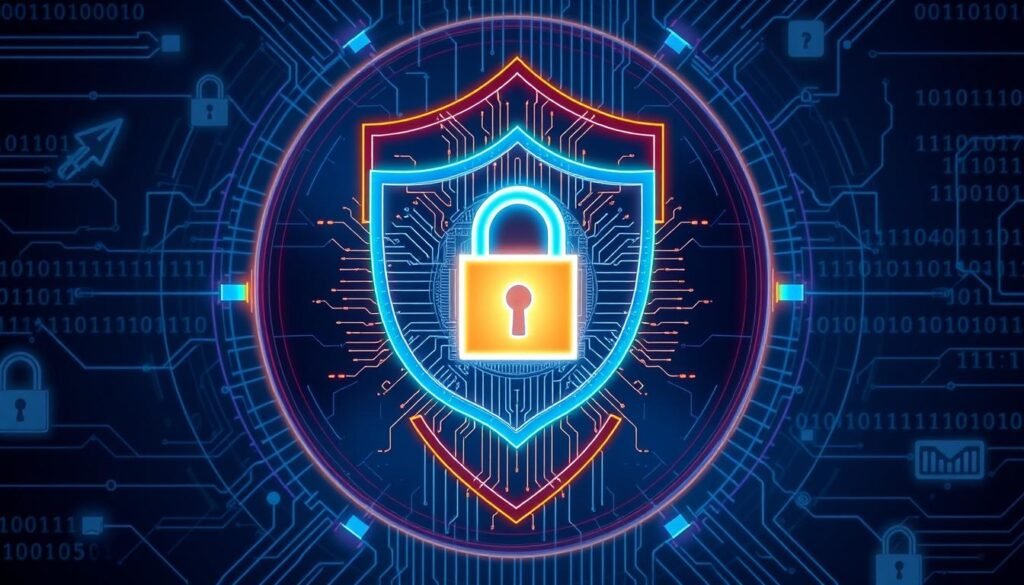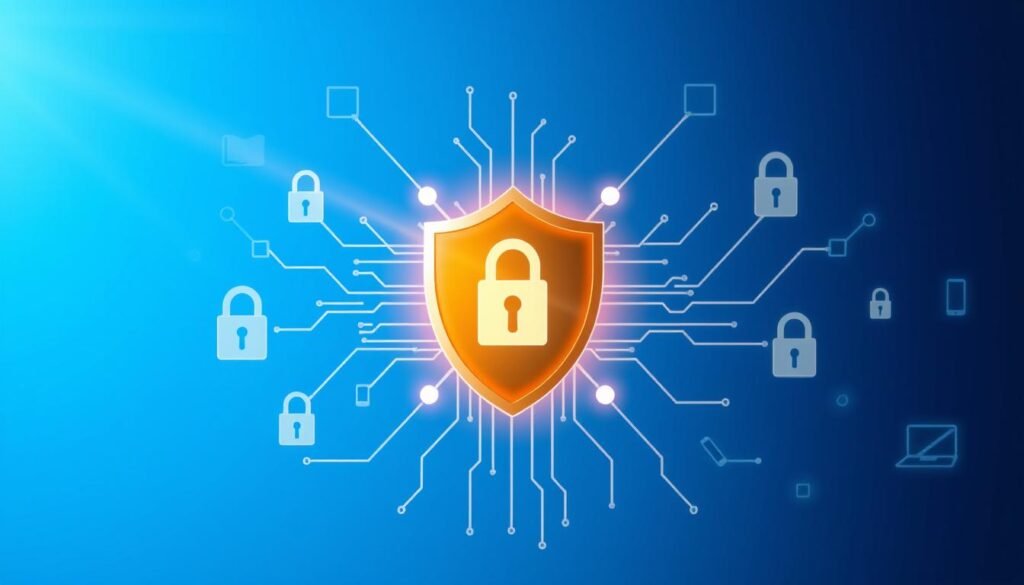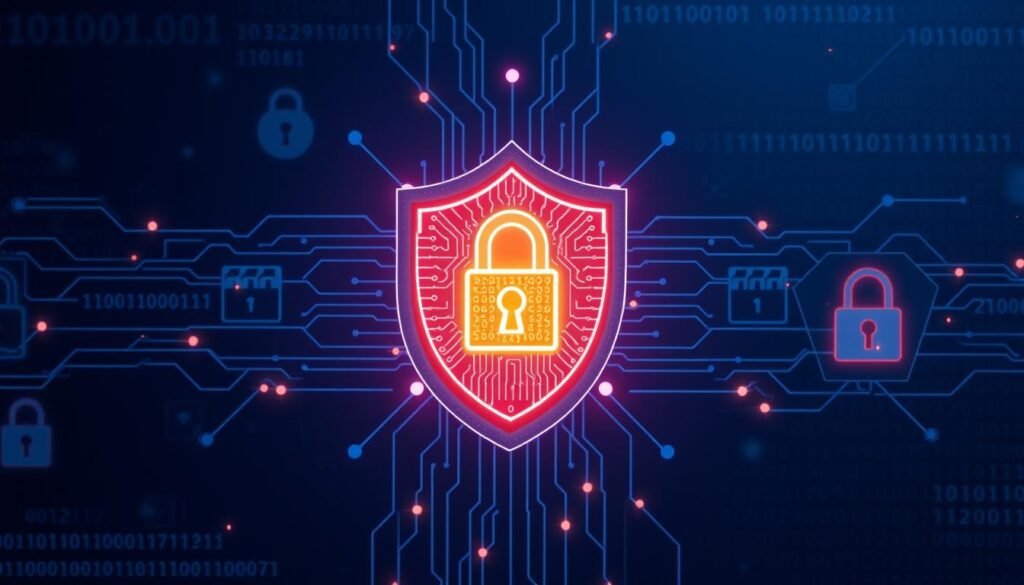Imagine waking up to find your identity stolen and your bank account empty. This is a harsh reality for many due to online fraud. Scammers target money and identity, posing a big threat to our safety online.
With the rise of internet scams, it’s vital to know how to protect ourselves. Online security is key to keeping our personal info safe.
Online fraud keeps changing, so we must stay updated on new threats. Scammers use tactics like phishing and email scams to steal from us. With over 60% of identity theft happening online, protecting ourselves is more important than ever.

Key Takeaways
- Online fraud can lead to financial loss and identity theft
- Scammers primarily aim to steal money and identity
- Online security is essential to protect against cybercrime
- Phishing and email scams are common tactics used by scammers
- Identity theft can have severe consequences, including financial loss and damage to credit scores
- Staying informed and taking necessary measures can help prevent online fraud
- Multi-factor authentication can reduce the risk of unauthorized access by up to 99.9%
Understanding the Landscape of Online Fraud
Online fraud is a big problem, with phishing attacks and fraudulent websites on the rise. In 2022, online fraud cost U.S. consumers about $5.8 billion. This shows why we need strong fraud prevention to keep people and businesses safe from credit card fraud and cybercrime.
To grasp the world of online fraud, it’s key to know the different cybercrimes. These include:
- Phishing attacks: Scammers send emails or texts to get your personal and financial info.
- Fraudulent websites: Fake sites that look like real ones to steal your info.
- Credit card fraud: Someone uses your card without permission to buy things or get cash.
Knowing about online fraud and how to stop it helps you avoid financial loss and identity theft. Be careful when you click on links or share personal info online. Also, keep an eye on your credit card statements and report any odd activity.
The Psychology Behind Internet Scams
Understanding the psychology behind internet scams is key to avoiding cyber scams. Scammers use emotions like fear, greed, or love to trick people. It’s important to stay alert and think critically online.
Studies show that impulsive, risk-taking, or trusting people are more likely to fall for cyber scams. Those with lower cognitive ability, emotional intelligence, or self-esteem are also more vulnerable. Feeling lonely, stressed, or financially strained can make you more susceptible to internet scams.
To stay safe from cyber scams, be careful online and check the authenticity of requests. Scam alerts can keep you updated on new internet fraud tactics. By knowing the psychology behind cyber scams and protecting yourself, you can lower your risk of falling victim to financial fraud.
| Type of Scam | Description |
|---|---|
| Phishing Scams | Scams that use fake emails or messages to trick victims into revealing sensitive information |
| Romance Scams | Scams that use emotional appeals to trick victims into sending money or revealing sensitive information |
| Investment Scams | Scams that use fake investment opportunities to trick victims into sending money |
Most Common Types of Online Fraud Today
Online fraud is a big problem, with many scams targeting people and businesses. Knowing the common types of online fraud is key to staying safe. This includes phishing, email scams, social media scams, investment scams, and romance scams. Fraud detection techniques help spot and stop these scams, which often pose cybersecurity threats and involve fraudulent transactions.
Some common online fraud types are:
- Phishing and email scams, which can cause online security risks and financial losses
- Social media fraud, which can put personal data at risk and lead to identity theft
- Investment and cryptocurrency scams, which can result in big financial losses
- Romance and dating scams, which can cause emotional and financial harm
To fight these risks, using good fraud detection techniques and staying up-to-date on cybersecurity threats is crucial. Knowing about these scams and protecting yourself can lower the chance of falling victim to fraudulent transactions and online security risks.
Being careful is the best way to avoid online fraud. By staying informed and taking steps to protect your data and money, you can lower your risk of falling prey to these scams.
Warning Signs of Fraudulent Activities
When you’re online, it’s key to know the signs of fraudulent activities. Over 70% of scams happen online, showing how digital fraud is on the rise. To avoid phishing scams and other online fraud, stay alert and use scam prevention methods.
Watch out for suspicious emails or texts that want you to click links or open attachments. If you get such a message, think: Do I really know the company or person who sent it? Be wary of messages that rush you or ask for personal or financial details.
To shield yourself from fraudulent activities, learn about the latest digital fraud detection ways. Stay updated on the scams going around. By being proactive and preventing online fraud, you can lower your risk of being scammed.
Here are more tips for scam prevention:
- Be careful of messages or calls you didn’t ask for that want your personal or financial info
- Make sure websites and online places are real before sharing sensitive info
- Use strong, different passwords and turn on two-factor authentication when you can
Identity Theft: The Silent Cybercrime
Identity theft is a big problem in today’s digital world. About 15 million people in the U.S. fall victim to it each year. It can lead to big financial losses and harm your reputation. Online scams, like phishing, are common ways thieves get your personal info.
Keeping your online security strong is key to avoiding identity theft. Stay alert when you’re online and protect your personal data. This means being careful with links and info you share, using strong passwords, and turning on two-factor authentication.
How Identity Theft Occurs
Identity theft happens in many ways, like data breaches and phishing attacks. Thieves use stolen info for scams, like fake accounts or unauthorized transactions. It’s important to know these threats and protect yourself.
Impact on Victims
Victims of identity theft often spend 200 hours trying to fix their situation. They can lose a lot of money, with losses reaching $50 billion a year. It also causes emotional stress and can hurt your credit score.
| Type of Identity Theft | Percentage of Cases |
|---|---|
| Synthetic Identity Theft | 85% |
| Medical Identity Theft | 10% |
| Financial Identity Theft | 5% |
Recovery Steps
Act fast if you’re a victim of identity theft. Report it to the right people and protect your data. This means watching your credit, changing passwords, and using two-factor authentication. Being proactive can help you recover and stay safe online.
Protecting Your Digital Financial Life
The world is getting more digital, and so are virtual crimes and fraudulent transactions. It’s crucial to protect your digital money. Knowing about digital fraud and how to stop it is key. Using fraud detection tools and services is a great way to do this.
Recently, about 353 million people faced cyber fraud and security threats. This shows we all need to be careful. Here are some ways to protect yourself:
- Check your bank and credit card statements often for odd activity
- Don’t use public Wi-Fi for financial stuff
- Be careful with emails and messages that seem urgent
- Use multi-factor authentication for extra security
By following these tips, you can lower your risk of falling for virtual crimes and fraudulent transactions. It’s also vital to stay updated on new digital fraud tricks. Always report any odd activity to the right people. Keeping your digital money safe is a job that never ends.
By being proactive and taking the right steps, you can shield yourself from virtual crimes and fraudulent transactions. This way, your digital money stays safe.

Essential Online Security Measures
To keep your online data safe, it’s key to use strong security steps. Start with password management. Make sure your passwords are long, with letters, numbers, and symbols. Avoid simple passwords like “password1234.”
Online fraud protection gets a boost from two-factor authentication. Microsoft says it stops 99.9% of automated cyberattacks. Also, always use secure websites with “https” when you’re shopping online.
Some important online security steps include:
- Using strong and unique passwords for each account
- Enabling two-factor authentication whenever possible
- Keeping software and operating systems up to date with the latest security patches
- Being cautious when clicking on links or downloading attachments from unknown sources
By following these steps, you can lower your risk of online fraud and cybercrime. Always stay alert and keep your security up to date to protect yourself.
| Online Security Measure | Description |
|---|---|
| Password Management | Using strong and unique passwords for each account |
| Two-Factor Authentication | Enabling two-factor authentication whenever possible |
| Secure Network Practices | Using security-enabled websites with “https” addresses |
The Role of Technology in Fraud Prevention
Technology is key in stopping online fraud, like online banking fraud. Advanced security software helps keep information safe. Cyber security tools, like encryption and firewalls, block unauthorized access.
Browser security tools also play a big role. They catch and stop harmful websites and malware. Plus, mobile device protection is crucial, as many use phones for banking and other sensitive tasks.
Technologies like artificial intelligence (AI) and machine learning (ML) are used to fight fraud. They help spot and stop threats like phishing and identity theft. This way, people and businesses can stay safe online.
To keep safe from fraud, it’s important to know about new threats. Always update your security software and use strong passwords. Also, be careful when you click on links or share personal info online.
| Technology | Description |
|---|---|
| AI | Artificial intelligence used to detect and prevent online threats |
| ML | Machine learning used to improve fraud detection and prevention |
| Encryption | Technology used to protect sensitive information from unauthorized access |
What to Do If You Become a Victim of Online Fraud
Being a victim of online fraud can be very upsetting. It can lead to financial losses and harm your online security. If you think you’ve been targeted by phishing schemes or virtual crimes, it’s important to act fast. The Federal Trade Commission (FTC) says Americans lost over $8.8 billion to fraud in 2022. Online shopping fraud alone caused over $1.5 billion in losses.
To avoid fraudulent transactions, know the warning signs. Look out for unexpected emails or messages asking for personal info. Also, be cautious of suspicious links or attachments and unfamiliar websites or apps asking for sensitive info. If you see these signs, report it to the right authorities right away.
Here are some steps to take if you’ve been a victim of online fraud:
- Stop transferring money or merchandise immediately
- Report the incident to the FTC and your local authorities
- Monitor your financial accounts and credit reports for any suspicious activity
- Consider placing a fraud alert on your credit files
Online security is everyone’s responsibility. By staying alert and taking the right steps, you can help stop phishing schemes and virtual crimes. Stay informed, stay safe, and always put your online security first.

| Type of Fraud | Number of Incidents | Losses |
|---|---|---|
| Phishing scams | over 300,000 | $1.5 billion |
| Online shopping fraud | not available | $1.5 billion |
| Business email compromise scams | not available | $124,000 (average loss) |
Building a Personal Cybersecurity Strategy
To keep your online data safe, you need a personal cybersecurity plan. Start by being careful with emails and links from unknown senders. Remember, “Be careful. Don’t open attachments or links you weren’t expecting.” This simple step can greatly improve your online safety.
Regular security checks are key to your plan. Keep an eye on your online activities, update your software, and use good antivirus software. These steps help block cyber threats and keep your digital protection current.
Learning about cyber threats and how to avoid them is also important. Stay updated on the latest online dangers and safety tips. By combining these steps, you can create a strong cybersecurity plan. This plan will help protect you from online threats and keep your digital world safe.
Legal Rights and Reporting Procedures
Knowing your legal rights and how to report online crimes is key to staying safe online. If you fall victim to online fraud, it’s important to know how to report it. This helps you get the help you need.
The FBI, United States Secret Service, and United States Immigration and Customs Enforcement (ICE) fight online crimes. They have offices in every state. You can report federal crimes by calling and asking for the “Duty Complaint Agent”.
To report cyber crimes, you can use the Internet Crime Complaint Center (IC3). It’s a place where you can report online crimes to the FBI. The IC3 gets a lot of complaints and helps fight cybercrime.
- Over $37 billion dollars reported lost due to cyber-enabled crimes from 2019 to 2023.
- The IC3 serves as the central hub for reporting cyber-enabled crime, run by the FBI.
- Crimes against children should be reported to the National Center for Missing and Exploited Children.
Knowing your rights and how to report crimes helps keep you safe online. Always be careful when you’re online. If something seems off, report it to the right people.
Conclusion: Staying One Step Ahead of Online Fraudsters
The online world is full of digital fraud and cybercrime threats that keep changing. But, we can fight back by being careful and proactive. We need a strong cybersecurity strategy that includes good habits, top-notch security tools, and knowing the latest scams.
Online security is a constant fight, not just a quick fix. Keep checking your digital defenses, learn about new threats, and use technology to your advantage. With the right digital fraud protection, you can safely enjoy the digital world.
Stay up to date, stay watchful, and listen to your gut. Together, we can make the internet safer for everyone. Let’s aim for a future where cybercrime prevention is common, and online security breaches are rare.
FAQ
What is online fraud and what are its consequences?
Online fraud is when people use the internet to commit crimes like stealing money or identities. It can cause big problems, like losing money, damaging your credit, and losing personal info.
What are the main goals of online scammers?
Online scammers want to get your financial info, steal your identity, and take your money. They use tricks like fake emails and websites to do this.
How has online fraud evolved over time?
Online fraud has gotten smarter, with scammers using new ways to trick people. The internet and online shopping have made it easier for them to scam more people.
What are the most common types of online fraud?
Common scams include fake emails, social media tricks, investment scams, and romance scams. These scams try to get you to give out personal info or make bad deals.
How can I recognize the warning signs of fraudulent activities?
Watch out for weird emails, texts, or online chats. Be careful if someone asks for your personal info or offers something too good to be true. Always be careful online to avoid scams.
What is identity theft, and how can I protect myself from it?
Identity theft is when someone uses your personal info for bad things. To avoid it, keep your online info safe, use strong passwords, and check your accounts often.
How can I safeguard my digital financial life?
Use strong security like two-factor authentication and check your accounts often. This helps keep your money and info safe from fraud.
What are the essential online security measures I should take?
Use strong passwords, enable two-factor authentication, and only connect to secure networks. These steps can help protect you from online scams.
How can technology help prevent online fraud?
Tech tools like security software and mobile protection can help keep you safe online. Using these tools can lower your risk of falling victim to fraud.
What should I do if I become a victim of online fraud?
If you get scammed, act fast to protect yourself. Report it, check your accounts, and take steps to stop more scams.
Source Links
- https://www.fdic.gov/consumer-resource-center/2021-10/avoiding-scams-and-scammers
- https://digital.va.gov/cyber-spot/how-to-protect-yourself-from-cyber-attacks-and-scams/
- https://consumer.ftc.gov/articles/how-recognize-and-avoid-phishing-scams
- https://tyfone.com/podcast/understanding-the-evolving-landscape-of-financial-fraud-with-uku-tomikas/
- https://www.pingidentity.com/en/resources/blog/post/everything-need-know-online-fraud.html
- https://stripe.com/guides/state-of-online-fraud
- https://www.consilien.com/news/the-psychology-behind-falling-for-a-cyber-scam
- https://www.m1cu.org/news/articles/the-psychology-behind-scams-why-people-get-fooled
- https://www.paymentnet.jpmorgan.com/help/auth/PaymentNet_Security_Best_Practices/What_to_Do_If_You_Suspect_Fraud/Types_of_Online_Fraud.htm
- https://www.experian.com/blogs/ask-experian/the-latest-scams-you-need-to-aware-of/
- https://www.consumerfinance.gov/ask-cfpb/what-are-some-classic-warning-signs-of-possible-fraud-and-scams-en-2094/
- https://corporatefinanceinstitute.com/resources/esg/fraud-red-flags/
- https://complyadvantage.com/insights/how-to-detect-fraud-red-flags/
- https://www.aratek.co/news/what-is-identity-theft-an-overview-in-todays-cyber-world
- https://www.idfy.com/blog/identity-theft-cyber-crime-the-silent-threat-of-the-digital-age/
- https://vocal.media/criminal/cyber-crime-the-silent-menace-of-the-digital-age
- https://www.bankbv.com/resources/blog-post/protect-your-digital-life-essential-tips-year-round-cybersecurity
- https://www.bannerbank.com/financial-resources/blog/tips-to-prevent-online-fraud
- https://www.gncu.org/blog/how-to-stay-cyber-safe-tips-for-protecting-your-finances-online/
- https://bettermoneyhabits.bankofamerica.com/en/privacy-security/online-security-privacy-tips
- https://consumer.ftc.gov/articles/protect-your-personal-information-hackers-and-scammers
- https://www.snbsd.com/about/online-safety-guide
- https://www.tookitaki.com/compliance-hub/the-role-of-technology-in-fraud-investigations
- https://www.softwebsolutions.com/resources/role-of-ai-in-fraud-prevention.html
- https://equarium.hannover-re.com/4930-five-ways-technology-can-enhance-fraud-prevention
- https://consumer.ftc.gov/articles/what-do-if-you-were-scammed
- https://www.cftc.gov/LearnAndProtect/AdvisoriesAndArticles/6Steps.html
- https://www.office1.com/blog/cybersecurity-strategy
- https://www.ncoa.org/article/how-older-adults-can-improve-their-personal-cyber-security/
- https://www.morganstanley.com/articles/personal-cybersecurity
- https://www.justice.gov/criminal/criminal-ccips/reporting-computer-internet-related-or-intellectual-property-crime
Click here to learn more about this topic in a related article.





